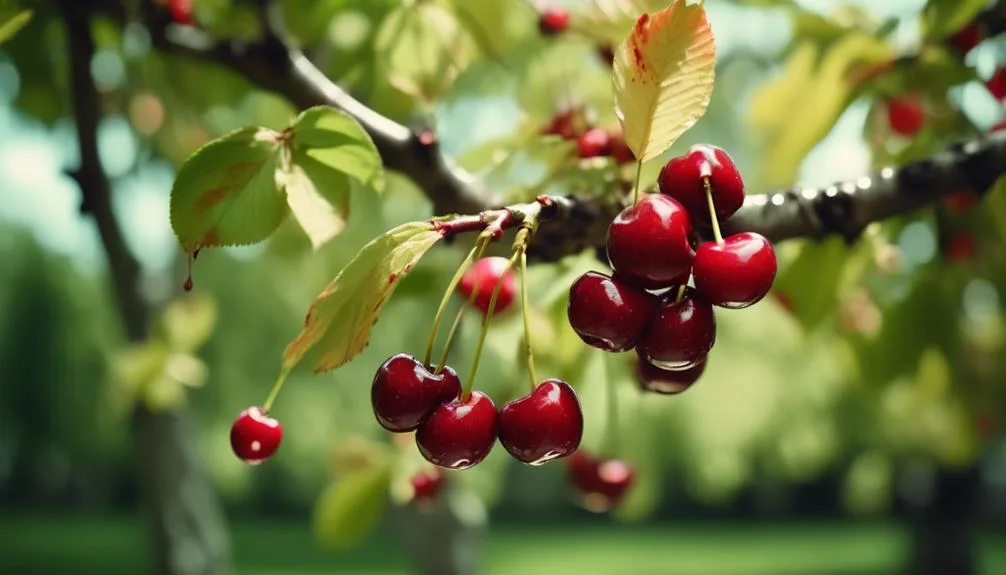Discover practical ways to keep your cherry trees healthy and free from common diseases.
Learn how to spot early signs of illness, apply effective treatments, and prevent future problems.
This guide offers valuable insights to ensure your beloved trees thrive and bloom beautifully.
Let's explore the best practices for nurturing these trees and keeping them disease-free.
Identifying Cherry Tree Diseases
Identifying cherry tree diseases begins with observing the leaves, branches, and fruits for any signs of discoloration, distortions, or unusual growth. Early signs of cherry tree diseases include spots, holes, or wilting leaves, deformed fruits, and abnormal growths on branches.
It's crucial to catch these signs early to prevent the spread of diseases. Once you have identified any abnormalities, it's time to focus on disease management. Pruning affected branches, removing infected leaves and fruits, and ensuring proper sanitation around the tree are essential steps.
Additionally, using fungicides and pesticides can help manage and prevent cherry tree diseases. By promptly identifying early signs and implementing effective disease management practices, you can protect your cherry tree and ensure a healthy, fruitful harvest.
Preventative Measures
To prevent cherry tree diseases, it is important to regularly inspect the tree for any signs of abnormalities and implement proactive measures to maintain its health and vigor. Proper pruning techniques and soil maintenance are crucial in preventing diseases. Pruning helps remove dead or diseased branches, improving air circulation and sunlight exposure, which are essential for the tree's health. Additionally, maintaining well-draining soil and appropriate pH levels can prevent root rot and other soil-borne diseases. Here's a simple guide to help you in preventing cherry tree diseases:
| Pruning Techniques | Soil Maintenance |
|---|---|
| Regularly prune to remove dead or diseased branches. | Ensure well-draining soil to prevent root rot and other soil-borne diseases. |
| Prune during the tree's dormant season to minimize stress. | Maintain appropriate pH levels for optimal tree health. |
Implementing these preventative measures will help keep your cherry tree healthy and disease-free.
Fungal Disease Treatment
Regularly inspecting your cherry tree for signs of abnormalities can help in identifying and treating fungal diseases that may affect its health and vigor.
When it comes to fungal disease treatment, there are several key practices to keep in mind:
- Pruning techniques: Proper pruning can improve air circulation and sunlight exposure, reducing the favorable conditions for fungal growth.
- Soil management: Ensuring well-draining soil and proper mulching can help prevent waterlogged conditions that promote fungal diseases.
- Fungicidal treatments: Applying appropriate fungicides can help control and prevent fungal infections on your cherry tree.
- Disease-resistant varieties: Consider planting cherry tree varieties that are naturally resistant to common fungal diseases to minimize the risk of infection.
Bacterial Infection Solutions
To effectively combat bacterial infections on your cherry tree, proper sanitation and prompt removal of infected plant material are essential.
Pruning techniques play a crucial role in managing bacterial infections. When pruning, make sure to remove dead or diseased branches, cutting at least 6 inches below the infected area.
Disinfect your pruning tools with a solution of 70% alcohol or 10% bleach to prevent spreading the bacteria.
Additionally, practicing good soil management can help prevent bacterial infections. Ensure proper drainage to avoid waterlogged soil, as excess moisture can create a favorable environment for bacterial growth.
Consider using mulch to prevent soil splashing onto the tree, as this can spread bacteria.
Pest Control Strategies
Combatting bacterial infections is essential for maintaining the health of your cherry tree. Now, we'll address effective pest control strategies to further safeguard your tree's well-being. When it comes to pest control, integrated pest management techniques are crucial for keeping your cherry tree healthy and thriving.
Here are some strategies to consider:
- Encourage natural predators such as ladybugs and lacewings to control harmful pests.
- Regularly prune and remove dead or diseased branches to prevent pest infestations.
- Use insecticidal soaps or horticultural oils to manage pest populations without harming beneficial insects.
- Employ physical barriers like row covers to protect your cherry tree from pests while allowing air, light, and water to reach the tree.
Conclusion
In caring for your cherry tree, vigilance and timely intervention can ensure its long-term health and beauty. By promptly addressing any signs of disease and implementing effective treatment and prevention methods, you can safeguard your tree from common ailments.
With proper care, your cherry tree can continue to flourish and grace your surroundings for years to come.

My interest in trees started when I first saw the giant sequoias in Yosemite.
I was a teenager then, and I remember thinking, “I need to learn more about this.”
That moment stuck with me.
A few years later, I went on to study forestry at Michigan Tech.
Since graduating, I’ve worked in a mix of hands-on tree care and community education.
I’ve spent over ten years helping people understand how to plant, maintain, and protect the trees in their neighborhoods.
I don’t see trees as just part of the landscape.
They are living things that make a real difference in our daily lives.
